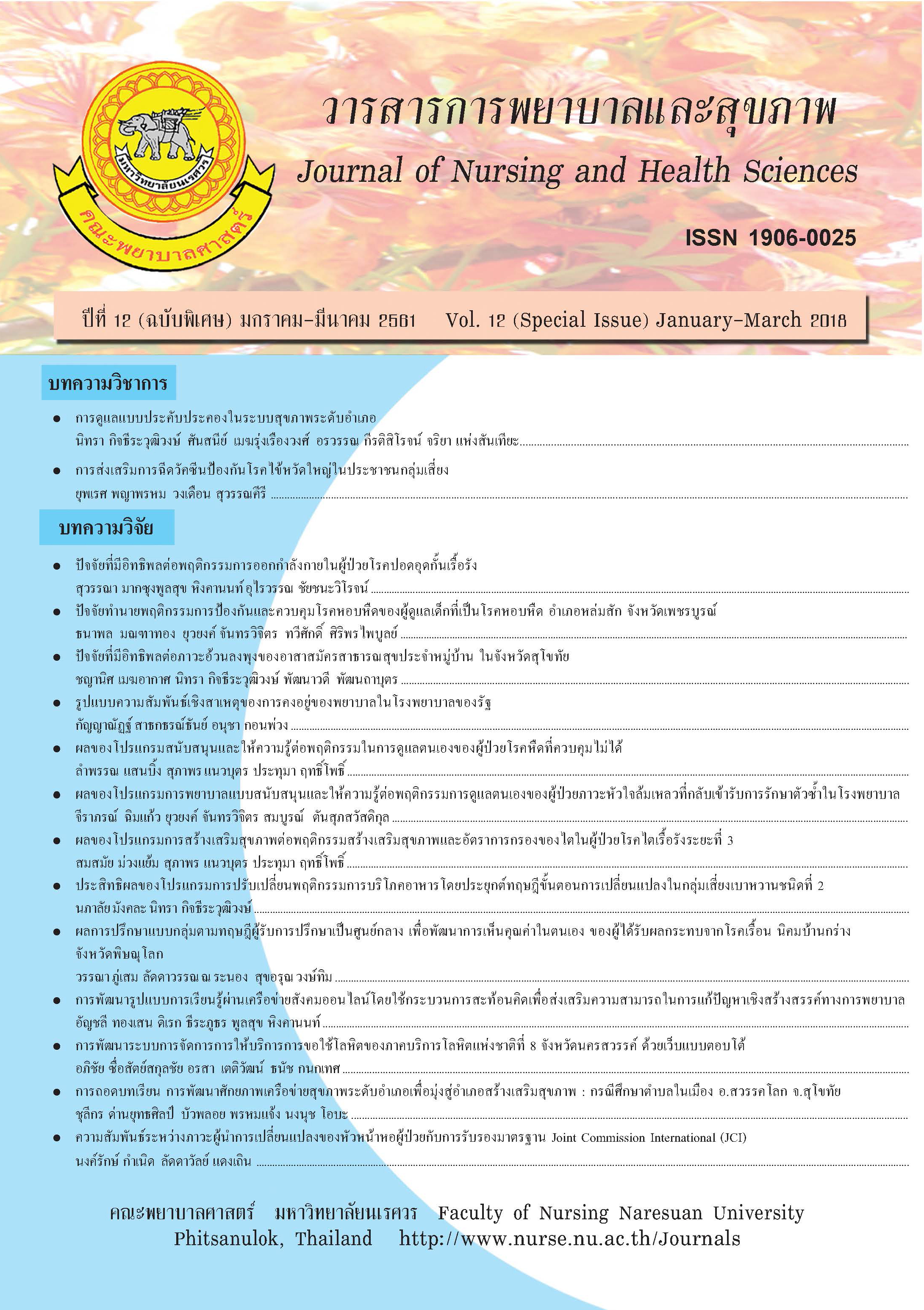Palliative Care in District Health System
Main Article Content
Abstract
The traditional concept of palliative care begins when patient was diagnosed from the physician that a cure is no longer possible and becomes to the end of life. However, at the present, palliative care covers the early identification to bereavement management of any kind – physical, psychological, social, and spiritual. It promotes patient adaptation, relieves suffering and enhance quality of life with the time remaining. Palliative care caters in hospital, stand-alone palliative care unit, or patients’ home which were coordinating and contributing to continuum of care. Palliative care concept involves accessibility, planning, preparing team work for identifying patients’ and family needs, patient-center care, holistic care, coordinating for obtaining support from health sector and social sector, and continuity of care. Therefore, district health system should combine health sector, local sector, and people sector working together to serve people in the catchment area. However, at present palliative care in district health system is less integrated. Building a network of palliative care by apply the palliative care concept and integrate the 6 buildings in planning palliative care services will be providing seamless palliative care.
Article Details
References
และเครือข่าย Palliative Care ในโรงเรียนแพทย์.
ใน บุษยามาส ชีวสกุลยง (บรรณาธิการ),
การดูแลผู้ป่วยแบบประคับประคอง (พิมพ์
ครั้งที่ 1,หน้า 1-12). เชียงใหม่: บริษัทกลางเวียง
การพิมพ์ จำกัด.
โรงพยาบาลสงฆ์ กรมการแพทย์ กระทรวงสาธารณสุข.
(2551). แนวทางเวชปฏิบัติการดูแลรักษาแบบ
ประคับประคอง. กรุงเทพฯ: บริษัท สินทวีการ
พิมพ์ จำกัด.
กรมการแพทย์ กระทรวงสาธารณสุข. (2557). แนวทาง
การดูแลผู้ป่วยระยะสุดท้าย.นนทบุรี: กระทรวง
สาธารณสุข.
กระทรวงสาธารณสุข. (2560). แนวทางการดำเนินงาน
คลินิกหมอครอบครัวสำหรับหน่วยบริการ.
นนทบุรี: กระทรวงสาธารณสุข.
จอนผะจง เพ็งจาด. (2557). บทบาทพยาบาลในการดูแล
แบบประคับประคอง.วารสารวิทยาลัยพยาบาล
บรมรานี กรุงเทพ, 30(1), 100-109.
ทัศนีย์ ทองประทีป. (2549). จิตวิญญาณ: มิติหนึ่งของ
การพยาบาล. กรุงเทพฯ: บุญศิริการพิมพ์.
นิทรา กิจธีระวุฒิวงษ์ และวุฒิชัย จริยา. (2558). การดำเนิน
การระบบบริการสุขภาพระดับอำเภอภายใต้
กรอบแนวคิดการสาธารณสุขมูลฐาน. วารสาร
การพยาบาลและการดูแลสุขภาพ, 33(3), 6-16.
พัชระกรพจน์ ศรีประสาร, วรธิดา มาศเกษม, และอนงค์
ดิษฐสังข์. (2558). การดูแลผู้ป่วยแบบประคับ
ประคองที่บ้าน : ความท้าทายในบทบาทของ
พยาบาลสาธารณสุข. วารสารพยาบาลสาธารณสุข,
29(2), 98-109.
พิไลพร สุขเจริญ และวาสินี วิเศษฤทธิ์. (2557).
ระบบบริการพยาบาลแบบประคับประคองใน
โรงพยาบาลระดับตติยภูมิ. วารสารเกื้อการุณย์,
21(Supplement), 155-167.
มูลนิธิสถาบันวิจัยและพัฒนาผู้สูงอายุไทย. (2558).
สถานการณ์ผู้สูงอายุไทย พ.ศ. 2557. กรุงเทพฯ:
บริษัทอมรินทร์พริ้นติ้งแอนด์พับลิชชิ่ง จำกัด
(มหาชน).
วัลภา คุณทรงเกียรติ. (2553). การดูแลแบบ
ประคับประคองในผู้ป่วยภาวะวิกฤตระยะ
สุดท้าย: บทบาทที่ท้าทายของพยาบาล. วารสาร
คณะพยาบาลศาสตร์ มหาวิทยาลัยบูรพา,
18(2), 1-7.
ศศิธร ธนะภพ และ รพีพร ขวัญเชื้อ. (2558). ความจำเป็น
ของการดูแลแบบประคับประคองในชุมชนของ
ผู้ป่วยโรคเรื้อรังระยะท้าย: กรณีศึกษาเครือข่าย
บริการปฐมภูมิแห่งหนึ่ง. วารสารสาธารณสุข
ศาสตร์ มหาวิทยาลัยบูรพา, 10(2), 13-25.
สำนักงานคณะกรรมการสุขภาพแห่งชาติ. (2558).
คู่มือการดูแลผู้ป่วยสูงอายุระยะสุดท้ายแบบ
ประคับประคอง สำหรับทีมหมอครอบครัว.
นนทบุรี: บริษัทสร้างสื่อจำกัด.
สำนักงานหลักประกันสุขภาพแห่งชาติ. (2559).
คู่มือระบบการดูแลระยะยาวด้านสาธารณสุข
สำหรับผู้สูงอายุที่มีภาวะพึ่งพิงในพื้นที่ (Long
term care) ระบบหลักประกันสุขภาพแห่งชาติ
ปีงบประมาณ 2559. นนทบุรี: สำนักงาน
หลักประกันสุขภาพแห่งชาติ.
สำนักบริหารการสาธารณสุข สำนักงานปลัดกระทรวง
สาธารณสุข. (2557). ทีมหมอครอบครัว.
กรุงเทพฯ: โรงพิมพ์ชุมนุมสหกรณ์การเกษตร
แห่งประเทศไทย จำกัด.
Aapro, M. S. (2012). Supportive care and palliative
care: a time for unity in diversity. Annals of
Oncology, 23,1931-1934.
Abbey, J., Froggatt, K. A., Parker, D., & Abbey, B.
(2006). Palliative care in long-term care: a
system in change. International Journal Older
People Nursing, 1(1), 56-63.
Constand, M. K., MacDermid, J. C., Bello-Haas. V.D.,
& Law, M. (2014). Scoping review of patientcentered
care approaches in healthcare. BMC
Health Services Research, 14(271). doi:
10.1186/1472-6963-14-271
Effiong, A., & Effiong, A. I. (2012). Palliative care for
the management of chronic illness: a systematic
review study protocol.. BMJ Open 2012;
2:e000899. doi:10.1136/bmjopen-2012-000899
Fassier, T., Lautrette, A., & Ciroldi, M. (2005). Care at
the end of life in critically ill patients: the
European perspective. Current Opinion Critical
Care, 11(6), 616-623.
Fowler, R., & Hammer, M. (2013). End-of-Life Care in
Canada. Clinical Invesmentt Medicine, 36(3),
E127-E132.
Lamont, E. B. (2005). A demographic and prognostic
approach to defining the end of life. Journal of
Palliative Medicine, 8(Suppl 1), S12-S21.
Meghani, S. H. (2004). A concept analysis of palliative
care in the United States. Journal of Advance
Nursing, 46(2), 152-161.
Mularski, R. A., Dy, S. M., Shugarman, L. R.,
Wilkinson, A. M., Lynn, J., & Shekelle, P. G.
(2007). A Systematic Review of Measures of
End-of-Life Care and Its Outcomes. Health
Services Research, 42(5), 1848-1870.
National Cancer Institute. (2015). Dictionary of Cancer
Terms. Retrieved 10 December, 2016, from
http://www.cancer.gov/Templates/
db_alpha.aspx?CdrIDผ 46609
National Hospice Organization. (1993). Standard of a
hospice program of care. Arlington VA:
National Hospice Organization.
Sharma, J. (2013). Chronic disease management in the
South-East Asia Region: a need to do more.
WHO South-East Asia Journal of Public Health,
2(2), 79-82.
World Health Organization. (2007). Everybody’s
business: Strengthening health systems to
improve health outcomes. WHO’s framework
for action. Geneva: World Health Organization.
World Health Organization. (2010). Global status report
on non-communicable diseases. Geneva: World
Health Organization.
World Health Organization. (2016a). Planning and
implementing palliative care services: a guide
for programme managers. Geneva: World
Health Organization.
World Health Organization. (2016b). WHO Definition
of Palliative Care. Retrieved 23 September,
2016, from http://www.who.int/cancer/palliative/
definition/en/
Worldwide Palliative Care Alliance. (2014). Global atlas
on palliative care at the end of life. London:
World Hospice and Palliative Care Alliance.


